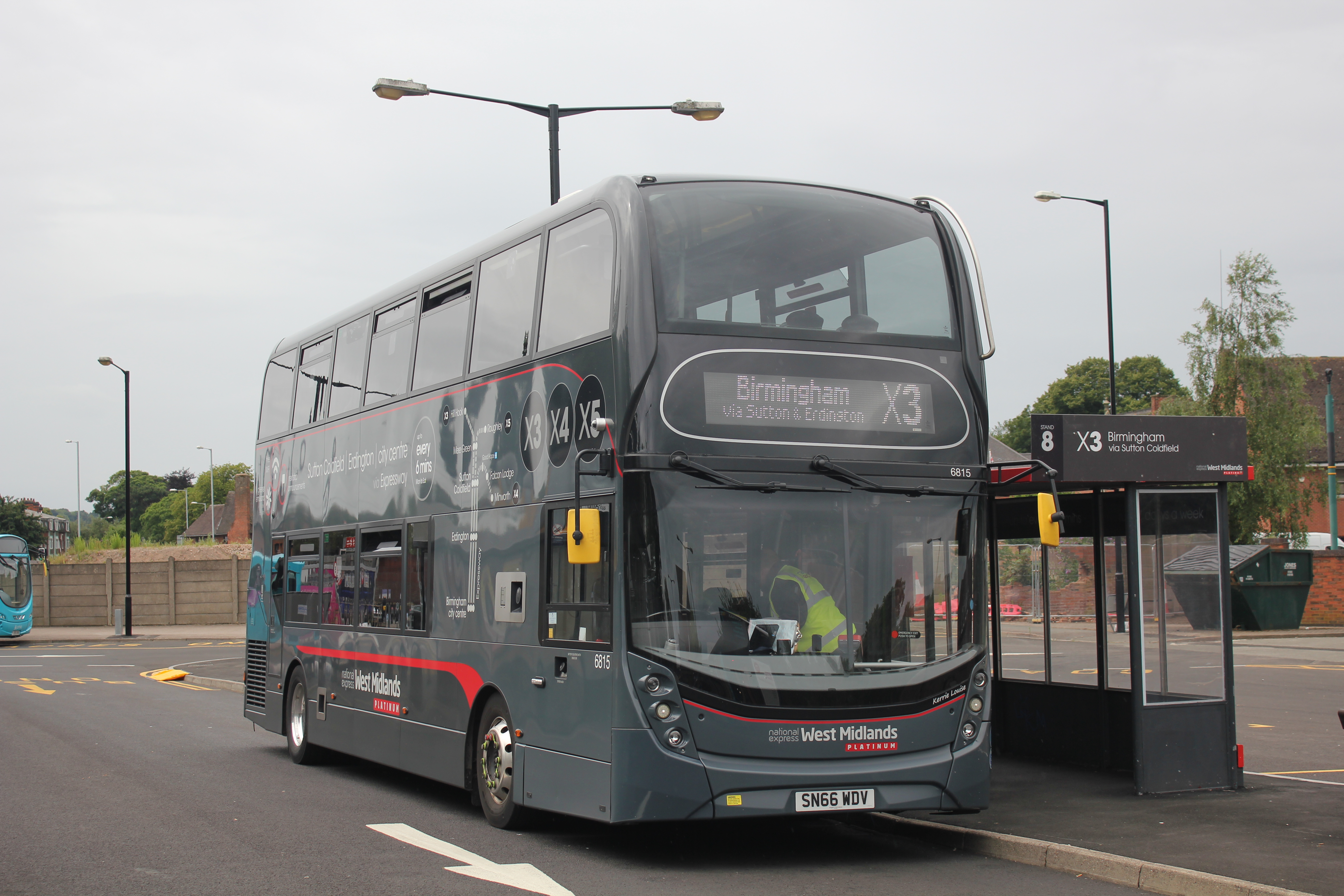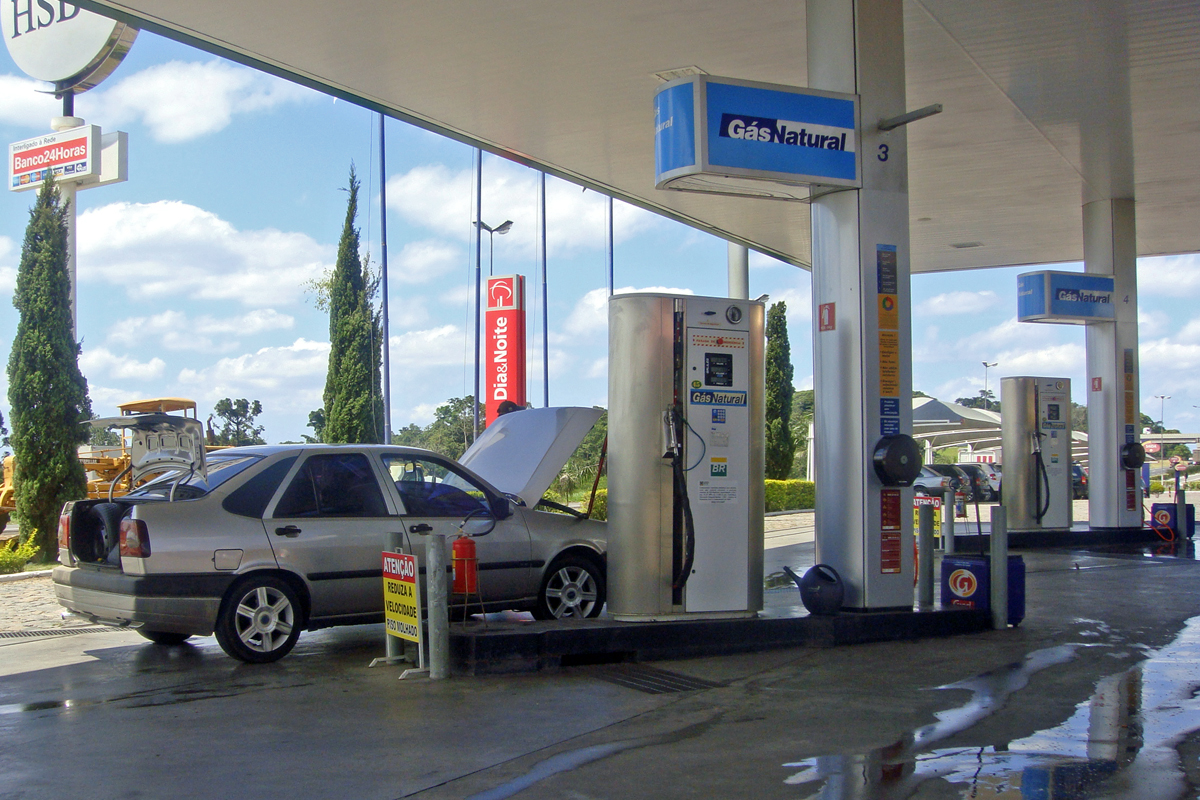|
ADL Enviro400 MMC
The Alexander Dennis Enviro400 MMC (sold as the Alexander Dennis Enviro400) is a low-floor double-decker bus produced by the British bus manufacturer Alexander Dennis since 2014, replacing the Alexander Dennis Enviro400. The Enviro400 MMC is produced at Alexander Dennis' Falkirk and Scarborough factories in the United Kingdom. The Enviro400 MMC is available as a complete integral bus – including an alternative styling, the Enviro400 City – or as a bus bodywork on Scania and Volvo chassis. A tri-axle variant, known as the Enviro400 XLB, is also produced. The Enviro400 MMC is available powered by either Euro VI diesel, compressed natural gas (CNG), hybrid-electric or fully-electric powertrains. Introduction The Enviro400 MMC can trace its design roots back to 1997, with the introduction of the Dennis Trident 2, one of the first low-floor double-decker buses to enter service. The model saw immense success at the turn of the millennium, despite financial difficulties facing ... [...More Info...] [...Related Items...] OR: [Wikipedia] [Google] [Baidu] |
Alexander Dennis
Alexander Dennis is a British bus manufacturing company based in Larbert, Scotland. The largest bus and coach manufacturer in the United Kingdom with a 50% market share in 2019, it has manufacturing plants and partnerships in Canada, China, Europe, Hong Kong, Malaysia, New Zealand, Singapore, South Africa and the United States. History TransBus - the precursor of Alexander Dennis Mayflower Corporation acquired Scottish bus-makers, Walter Alexander, in August 1995 and English bus-makers, Dennis Group, in October 1998. In 2000, Mayflower and Henlys Group merged their British bus-making operations into a 70:30 joint venture with Alexander, Dennis and Henlys' Plaxton merged to form TransBus International. The factories concerned employed 3,300 staff in seven places in England ( Anston, Guildford, Scarborough and Wigan), Scotland (Falkirk) and Northern Ireland (Belfast). Plaxton's Scarborough operations was planned to close on 3 May 2001 with the loss of 700 jobs blamed on the ... [...More Info...] [...Related Items...] OR: [Wikipedia] [Google] [Baidu] |
Scania AB
Scania AB is a major Swedish manufacturer headquartered in Södertälje, focusing on commercial vehicles—specifically heavy lorries, trucks and buses. It also manufactures diesel engines for heavy vehicles as well as marine and general industrial applications. Scania was formed in 1911 through the merger of Södertälje-based Vabis and Malmö-based Maskinfabriks-aktiebolaget Scania. Since 1912, the company has been re-located again to Södertälje after the merger. Today, Scania has production facilities in Sweden, France, the Netherlands, Thailand, China, India, Argentina, Brazil, Poland, Russia and Finland. In addition, there are assembly plants in ten countries in Africa, Asia and Europe. Scania's sales and service organisation and finance companies are worldwide. In 2012, the company employed approximately 42,100 people around the world. Scania was listed on the NASDAQ OMX Stockholm stock exchange from 1996 to 2014. The company is a subsidiary of Traton, part of the Vo ... [...More Info...] [...Related Items...] OR: [Wikipedia] [Google] [Baidu] |
Oxford Bus Company
Oxford Bus Company is the trading name of The City of Oxford Motor Services Ltd. Company Number 91106 It is a bus operator serving the city and surrounding area of Oxford, England. It is a subsidiary of the Go-Ahead Group. History Horse trams and horse buses The City of Oxford Tramways Company, City of Oxford and District Tramway Company served Oxford with Horsecar, horse-drawn trams from 1881. By 1898 its network served Abingdon Road, Banbury Road, Oxford, Banbury Road, Cowley Road, Oxford, Cowley Road, Walton Street, Oxford, Walton Street and both and railway stations. Horsebus, Horse bus services developed to complement the tramway network. By the early 20th century both Iffley Road and Woodstock Road, Oxford, Woodstock Road were horse bus routes. On Saturdays only there were horse buses from Headington to the city centre and from Cowley, Oxfordshire, Cowley village to the tram terminus in Cowley Road. In 1906 the City of Oxford Electric Traction Company took over from th ... [...More Info...] [...Related Items...] OR: [Wikipedia] [Google] [Baidu] |
NXWM Platinum ADL Enviro 400 MMC 6785 On 8
National Express West Midlands (NXWM) is a bus operator in the West Midlands that operates services in Birmingham, Dudley, Sandwell, Walsall, Wolverhampton, and Solihull, as well as limited routes outside of the general area of Birmingham, such as thX1to Coventry, or th144Ato Bromsgrove. NXWM is a subsidiary of National Express. History On 26 October 1986 as part of the deregulation of bus services, West Midlands Travel was formed. It was previously the bus operations of the West Midlands Passenger Transport Executive, which ceased to be a bus operator, but successor organisation Transport for West Midlands retains a co-ordinating role, funding infrastructure like bus stations, providing information, paying for socially necessary services, and concessionary fares. West Midlands Travel remained in public ownership under the West Midlands Passenger Transport Authority until December 1991, when it was sold in an Employee Share Ownership Plan to its management and employees. In ... [...More Info...] [...Related Items...] OR: [Wikipedia] [Google] [Baidu] |
Exeter Bus Station - Stagecoach 10690 (SN66VVA)
Exeter () is a city in Devon, South West England. It is situated on the River Exe, approximately northeast of Plymouth and southwest of Bristol. In Roman Britain, Exeter was established as the base of Legio II Augusta under the personal command of Vespasian. Exeter became a religious centre in the Middle Ages. Exeter Cathedral, founded in the mid 11th century, became Anglican in the 16th-century English Reformation. Exeter became an affluent centre for the wool trade, although by the First World War the city was in decline. After the Second World War, much of the city centre was rebuilt and is now a centre for education, business and tourism in Devon and Cornwall. It is home to two of the constituent campuses of the University of Exeter: Streatham and St Luke's. The administrative area of Exeter has the status of a non-metropolitan district under the administration of the County Council. It is the county town of Devon and home to the headquarters of Devon County Council. A p ... [...More Info...] [...Related Items...] OR: [Wikipedia] [Google] [Baidu] |
TransBus International
Alexander Dennis is a British bus manufacturing company based in Larbert, Scotland. The largest bus and coach manufacturer in the United Kingdom with a 50% market share in 2019, it has manufacturing plants and partnerships in Canada, China, Europe, Hong Kong, Malaysia, New Zealand, Singapore, South Africa and the United States. History TransBus - the precursor of Alexander Dennis Mayflower Corporation acquired Scottish bus-makers, Walter Alexander Coachbuilders, Walter Alexander, in August 1995 and English bus-makers, Dennis Specialist Vehicles, Dennis Group, in October 1998. In 2000, Mayflower and Henlys Group merged their British bus-making operations into a 70:30 joint venture with Alexander, Dennis and Henlys' Plaxton merged to form TransBus International. The factories concerned employed 3,300 staff in seven places in England (Anston, Guildford, Scarborough, North Yorkshire, Scarborough and Wigan), Scotland (Falkirk) and Northern Ireland (Belfast). Plaxton's Scarborough ... [...More Info...] [...Related Items...] OR: [Wikipedia] [Google] [Baidu] |
Dennis Specialist Vehicles
Dennis Specialist Vehicles was an English manufacturer of commercial vehicles based in Guildford, building buses, fire engines, lorries (trucks) and municipal vehicles such as dustcarts. All vehicles were made to order to the customer's requirements and more strongly built than mass production equivalents. For most of the 20th century the Dennis company was Guildford's main employer. Following a decade of financial difficulties original shareholders sold out in 1972 and Dennis's ownership has since passed through quite a number of hands. The Woodbridge site was sold and a new small factory built in Slyfield remains in use by lineal business descendant, bus-maker Alexander Dennis. No Dennis haulage trucks have been built since 1985. The last Dennis fire engine left the Guildford factory in 2007. The Dennis brand is still used on Alexander Dennis buses, Dennis Eagle dustcarts and Dennis mowers. Dennis Brothers 1895 to 1901 Dennis Brothers was founded in 1895 by brothers John Ca ... [...More Info...] [...Related Items...] OR: [Wikipedia] [Google] [Baidu] |
Dennis Trident 2
The Dennis Trident 2 is a 2-axle low-floor double-decker bus chassis originally manufactured by Dennis, which was unveiled in 1997 and replaced the Dennis Arrow. It was built by TransBus after Dennis was incorporated into the group in 2001, then from 2004, it was built by Alexander Dennis following the collapse of TransBus. Design The Trident 2 chassis features a transversely mounted engine on the right side, with the radiator mounted on the left side of the engine compartment. It could be fitted with C-series Euro II engine (later Cummins ISCe Euro III engine), coupled to Voith DIWA or ZF Ecomat gearbox. It was available with Alexander ALX400, Plaxton President and East Lancs Lolyne/ Myllennium Lolyne bodywork. Orders In the first few years of production, the Trident 2 was popular with a large number sold to large bus operators such as Stagecoach, FirstGroup, Travel West Midlands and Lothian Buses. A total of 2,255 Dennis Tridents would be built for London bus operators ... [...More Info...] [...Related Items...] OR: [Wikipedia] [Google] [Baidu] |
Electric Vehicle
An electric vehicle (EV) is a vehicle that uses one or more electric motors for propulsion. It can be powered by a collector system, with electricity from extravehicular sources, or it can be powered autonomously by a battery (sometimes charged by solar panels, or by converting fuel to electricity using fuel cells or a generator). EVs include, but are not limited to, road and rail vehicles, surface and underwater vessels, electric aircraft and electric spacecraft. For road vehicles, together with other emerging automotive technologies such as autonomous driving, connected vehicles and shared mobility, EVs form a future mobility vision called Connected, Autonomous, Shared and Electric (CASE) Mobility. EVs first came into existence in the late 19th century, when electricity was among the preferred methods for motor vehicle propulsion, providing a level of comfort and ease of operation that could not be achieved by the gasoline cars of the time. Internal combustion engin ... [...More Info...] [...Related Items...] OR: [Wikipedia] [Google] [Baidu] |
Hybrid Electric Vehicle
A hybrid electric vehicle (HEV) is a type of hybrid vehicle that combines a conventional internal combustion engine (ICE) system with an electric propulsion system ( hybrid vehicle drivetrain). The presence of the electric powertrain is intended to achieve either better fuel economy than a conventional vehicle or better performance. There is a variety of HEV types and the degree to which each function as an electric vehicle (EV) also varies. The most common form of HEV is the hybrid electric car, although hybrid electric trucks (pickups and tractors), buses, boats and aircraft also exist. Modern HEVs make use of efficiency-improving technologies such as regenerative brakes which convert the vehicle's kinetic energy to electric energy, which is stored in a battery or supercapacitor. Some varieties of HEV use an internal combustion engine to turn an electrical generator, which either recharges the vehicle's batteries or directly powers its electric drive motors; this combinatio ... [...More Info...] [...Related Items...] OR: [Wikipedia] [Google] [Baidu] |
Compressed Natural Gas
Compressed natural gas (CNG) is a fuel gas mainly composed of methane (CH4), compressed to less than 1% of the volume it occupies at standard atmospheric pressure. It is stored and distributed in hard containers at a pressure of , usually in cylindrical or spherical shapes. CNG is used in traditional petrol/internal combustion engine vehicles that have been modified, or in vehicles specifically manufactured for CNG use: either alone (dedicated), with a segregated liquid fuel system to extend range (dual fuel), or in conjunction with another fuel ( bi-fuel). It can be used in place of petrol (gasoline), diesel fuel, and liquefied petroleum gas (LPG). CNG combustion produces fewer undesirable gases than the aforementioned fuels. In comparison to other fuels, natural gas poses less of a threat in the event of a spill, because it is lighter than air and disperses quickly when released. Biomethane – refined biogas from anaerobic digestion or landfills – can be used. In ... [...More Info...] [...Related Items...] OR: [Wikipedia] [Google] [Baidu] |
.jpg)




.jpg)



